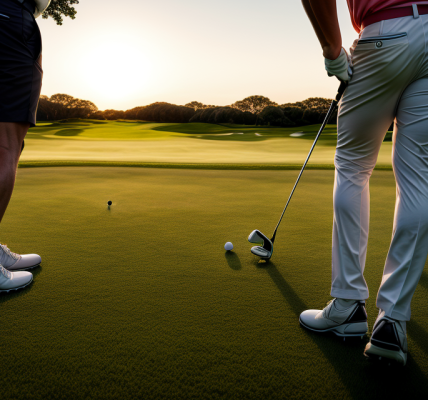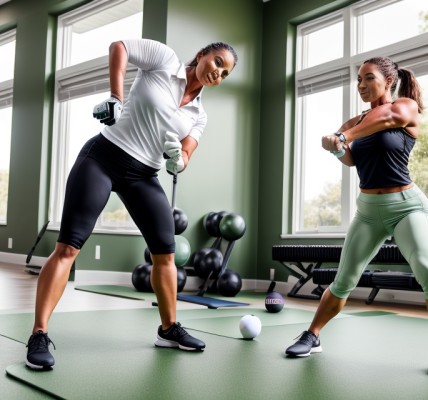Golfing is not just a sport, it’s a lifestyle. And, when it comes to fitness, golfing is often touted as a great way to get in shape. But, the million-dollar question is, does golfing really give you abs? The debate has been on for quite some time now, with some claiming that the sport is an excellent ab workout, while others argue otherwise. In this article, we will dive deep into the topic and uncover the truth about whether golfing can help you achieve a six-pack or not. So, get ready to tee off and find out if golfing is the ultimate ab workout or just a myth.
Golfing is a great way to stay active and improve your physical fitness, but it’s unlikely to give you a six-pack. While golfing does require some strength and stamina, it’s not a high-intensity workout that will lead to significant weight loss or muscle definition. However, golfing can still be a valuable part of a healthy lifestyle, as it provides an opportunity to get outside, enjoy the fresh air, and socialize with others. Additionally, the mental focus and strategic thinking required in golf can have numerous health benefits, including reducing stress and improving cognitive function. So while golfing may not give you abs, it can still be a fun and rewarding way to stay active and healthy.
The Myth of Golfing and Ab Development
The Connection Between Golfing and Abs
While golfing may not be the most effective way to achieve a six-pack, it does have some connection to abdominal muscle development. Here’s how:
- Burning Calories: Golfing is a relatively low-intensity activity that burns calories, which can help with weight loss and reduce body fat, including the visceral fat that surrounds the abdominal muscles. This reduction in body fat can make the abs more visible.
- Core Strength: Golf requires a strong core for stability and balance. Swinging a golf club and making accurate shots demand a strong core to maintain posture, balance, and power throughout the swing. As a result, golfing can contribute to the development of abdominal muscles, especially the obliques and rectus abdominis.
- Functional Fitness: Golfing also involves a lot of twisting and turning, which can improve functional fitness and core stability. This type of exercise can help develop the muscles used in everyday activities and sports, including the abdominals.
It’s important to note that while golfing can contribute to abdominal muscle development, it’s not the most effective exercise for this purpose. Traditional abdominal exercises like crunches, planks, and Russian twists are more targeted and effective for building a strong core and developing abs. However, incorporating golf into your fitness routine can be a fun and enjoyable way to improve your overall fitness and burn calories, which can help reveal your abs.
Debunking the Myth
While golfing may provide a full-body workout, it is important to debunk the myth that it automatically leads to six-pack abs. This misconception stems from the belief that simply engaging in any physical activity will result in visible abdominal muscles. However, the development of abdominal muscles is a complex process influenced by various factors.
One of the main reasons why golfing alone may not lead to visible abdominal muscles is that it primarily targets the lower body, including the legs and lower back. While it is true that golfing requires the use of core muscles, such as the rectus abdominis and obliques, it does not provide the same level of targeted training as specific abdominal exercises.
Another factor to consider is the importance of proper nutrition and a balanced diet in the development of abdominal muscles. While golfing can help burn calories and improve overall fitness, it is not a replacement for a healthy diet and regular strength training. In fact, simply losing weight through diet and exercise can lead to more noticeable abdominal definition than any single physical activity.
Additionally, genetics play a significant role in the development of abdominal muscles. Some individuals may have a naturally leaner or more muscular physique, which can affect the visibility of their abdominal muscles regardless of their level of physical activity.
In conclusion, while golfing can be a beneficial form of exercise, it is important to debunk the myth that it automatically leads to six-pack abs. The development of abdominal muscles is a complex process influenced by various factors, including targeted exercise, proper nutrition, and genetics.
The Science Behind Abdominal Muscle Development
Anatomy of the Core
Overview of the Muscles that Make up the Core
The core muscles are a group of muscles that are located in the center of the body, including the rectus abdominis, obliques, and transversus abdominis. The rectus abdominis is a long, flat muscle that runs vertically along the front of the abdomen and is responsible for flexing the spine and bending the body at the waist. The obliques are located on either side of the rectus abdominis and are responsible for twisting the torso and bending the body to the side. The transversus abdominis is a thin, horizontal muscle that wraps around the internal organs and is responsible for stabilizing the spine and protecting the organs during impact.
Explanation of the Functions of Each Muscle Group
The rectus abdominis is responsible for flexing the spine and bending the body at the waist, which is important for performing various movements such as bending over to pick up an object or swinging a golf club. The obliques are responsible for twisting the torso and bending the body to the side, which is important for rotating the body during a golf swing and maintaining balance. The transversus abdominis is responsible for stabilizing the spine and protecting the organs during impact, which is important for preventing injury during physical activity.
Overall, understanding the anatomy of the core muscles is crucial for understanding how golfing can affect abdominal muscle development. While golfing may not be the most effective exercise for targeting the rectus abdominis specifically, it can still provide a full-body workout that engages the core muscles and can lead to overall abdominal muscle development.
The Importance of a Balanced Workout
- When it comes to developing a strong and defined core, it’s important to understand that abdominal muscles are just one part of the equation.
- Incorporating exercises that target all muscle groups, not just the abs, is crucial for a balanced workout.
- This includes exercises that focus on the back, legs, and arms, as well as cardiovascular exercises to improve overall fitness.
- By incorporating a variety of exercises into your routine, you can ensure that you are working all the muscle groups in your body, which will help you achieve a more well-rounded physique.
- Some effective exercises for core strength training include planks, crunches, and Russian twists.
- It’s important to note that while these exercises can help strengthen your core muscles, they should be performed in conjunction with a balanced workout that includes a variety of exercises targeting all muscle groups.
- This approach will not only help you achieve a stronger, more defined core, but also improve your overall fitness and well-being.
Nutrition and Abdominal Muscle Development
Proper nutrition plays a crucial role in the development of abdominal muscles. A balanced diet that includes a variety of nutrients such as protein, carbohydrates, and healthy fats, is essential for muscle growth and recovery. Consuming adequate amounts of protein is particularly important, as it helps to repair and rebuild muscle tissue after exercise.
Additionally, staying hydrated is crucial for optimal muscle function. Dehydration can lead to decreased muscle strength and endurance, making it more difficult to perform physical activities, including golf. It is recommended to drink at least eight glasses of water per day to ensure proper hydration.
Furthermore, consuming a pre-workout snack that includes carbohydrates and protein can help to fuel the body during exercise and promote muscle growth. Examples of pre-workout snacks include a banana and a handful of almonds, or a protein shake.
Overall, proper nutrition is essential for abdominal muscle development, and golfers should focus on consuming a balanced diet that includes adequate amounts of protein, carbohydrates, and healthy fats, and staying hydrated to optimize muscle function.
Golf-Specific Exercises for Core Strength
Plank Variations
Plank variations are a type of exercise that is specifically designed to target the core muscles of the body, which can help improve the overall strength and stability of the body during the golf swing.
Benefits of Plank Variations for Golfers
Plank variations have several benefits for golfers, including:
- Improved core stability and balance
- Increased strength in the muscles of the core
- Better posture and alignment during the golf swing
- Reduced risk of injury
Step-by-Step Instructions for Proper Form and Execution
To perform plank variations with proper form and execution, follow these steps:
- Start in a push-up position with your hands directly under your shoulders and your body in a straight line from head to heels.
- Engage your core muscles by drawing your belly button towards your spine.
- Hold your body in this position for the desired amount of time, focusing on maintaining proper form and engaging your core muscles throughout.
- Repeat for the desired number of repetitions.
It is important to remember to engage your core muscles throughout the entire exercise to ensure that you are targeting the correct muscle groups and maximizing the benefits of the exercise. Additionally, it is important to start with lower repetitions and gradually increase the difficulty over time to avoid injury and build strength safely.
Side Plank
The side plank is a powerful exercise that can help golfers improve their core strength and stability. By strengthening the muscles on the side of the body, golfers can improve their balance and power when swinging the club.
Benefits of Side Planks for Golfers
The side plank is a great exercise for golfers because it targets the muscles on the side of the body, including the obliques, glutes, and hip flexors. These muscles are essential for maintaining proper posture and balance during the swing, and a strong core can help golfers transfer their weight efficiently and maintain a stable lower body throughout the swing.
In addition, the side plank can also help improve rotation and balance, which are crucial for a successful golf swing. A strong side plank can help golfers rotate their hips and torso more efficiently, allowing them to hit the ball with more power and accuracy.
Proper Form and Execution
To perform a side plank correctly, follow these steps:
- Start by lying on your side with your feet stacked on top of each other and your hands placed on the ground in front of your shoulders.
- Begin to lift your hips off the ground, using your core muscles to keep your body in a straight line from head to heels.
- Hold for 30-60 seconds, keeping your body in a straight line and your core muscles engaged.
- Slowly lower your hips back down to the ground and repeat for 2-3 sets.
It’s important to keep your body in a straight line and avoid sagging or dropping your shoulders during the side plank. Additionally, it’s important to engage your core muscles throughout the exercise to ensure proper form and prevent injury.
Overall, the side plank is a great exercise for golfers looking to improve their core strength and stability. By targeting the muscles on the side of the body, golfers can improve their balance, posture, and power during the swing, leading to more successful shots and lower scores.
Russian Twist
- Russian twists are a highly effective exercise for golfers to improve their core strength and stability.
- The exercise targets the muscles in the lower back, hips, and abs, which are crucial for maintaining proper posture and balance during the swing.
To perform a Russian twist, follow these steps:
- Start by sitting on the floor with your knees bent and feet flat.
- Place your hands behind your head, clasping your fingers together.
- Slowly twist your torso to the right, keeping your shoulders and hips in place.
- Pause for a moment, then return to the starting position.
- Repeat the movement to the left, twisting your torso to the left side.
- Perform 10-15 repetitions on each side, increasing the number of repetitions as your core strength improves.
It is important to maintain proper form during the exercise to avoid injury and maximize the benefits. Keep your shoulders and hips still, and do not let your knees or feet move during the twist. It is also important to breathe naturally and not hold your breath during the exercise.
Russian twists can be incorporated into a full core workout routine, or performed as a standalone exercise to target the muscles specifically used in golf. Incorporating Russian twists into your fitness routine can help improve your golf performance by increasing your core strength and stability, reducing your risk of injury, and improving your overall physical fitness.
The Link Between Golf Performance and Core Strength
Improved Swing Mechanics
Stronger Core Muscles Lead to Better Swing Mechanics
- Explain how a strong core is crucial for maintaining proper posture and balance during the swing
- Emphasize the importance of a stable core for generating power and transferring energy through the swing
- Highlight the connection between a strong core and a smooth, efficient swing
Specific Ways in Which Core Strength Translates to Better Golf Performance
- Enhanced weight transfer: Discuss how a strong core enables golfers to shift their weight effectively from one side to the other, improving balance and control throughout the swing
- Improved clubhead speed: Explain how a stable core allows golfers to generate maximum power and speed in their swings, leading to increased clubhead velocity
- Greater accuracy: Discuss how a strong core helps golfers maintain a consistent, smooth swing, reducing the risk of slicing or hooking the ball
- Better overall performance: Conclude by summarizing the various ways in which a strong core contributes to better golf performance, making it an essential aspect of any golfer’s training regimen
Reduced Risk of Injury
Golf is a sport that requires precision, accuracy, and control over every swing. The power behind a golfer’s swing relies heavily on their core strength, which is the foundation for their entire body. A strong core allows for better balance, stability, and rotation, leading to improved swing mechanics and reduced risk of injury.
One of the most significant benefits of a strong core is injury prevention. When the core muscles are weak, the body compensates by relying on other muscles, which can lead to muscle imbalances and increase the risk of injury. Golfers who lack core strength are more prone to developing lower back pain, shoulder injuries, and elbow pain, among other issues.
Core strength also plays a crucial role in reducing the risk of golf-related injuries. A study conducted by the Journal of Sports Sciences found that golfers with stronger core muscles were less likely to experience lower back pain and other injuries during their swing. This is because a strong core helps to maintain proper alignment and balance throughout the swing, reducing the strain on other muscles and joints.
In addition to reducing the risk of injury, a strong core also improves overall golf performance. Golfers with a strong core tend to have better control over their swing, resulting in more accurate shots and improved ball flight. A study published in the Journal of Sports Sciences found that golfers with higher levels of core strength had significantly lower shot dispersion, meaning their shots were more accurate and consistent.
In conclusion, while golfing may not give you abs directly, the core strength developed through regular golf training can lead to numerous health benefits, including a reduced risk of injury. Golfers who prioritize core strength training can improve their overall performance, reduce their risk of injury, and enjoy a more enjoyable and successful golfing experience.
Enhanced Endurance and Stamina
Engaging in regular golf activities can have a positive impact on your physical fitness, particularly in terms of enhancing your endurance and stamina. While the primary focus of golf is on precision and accuracy, having a strong core can contribute to improved overall performance on the golf course.
Core strength plays a crucial role in enhancing endurance and stamina, as it allows for more efficient energy expenditure during physical activity. Strong core muscles enable better posture, balance, and alignment, which in turn can reduce the risk of injury and improve overall athletic performance.
Moreover, having a strong core can enhance the power and speed behind your swings, enabling you to generate more force and control as you strike the ball. This is particularly important in golf, as even a slight miscalculation or loss of balance can result in a poor shot.
Additionally, a strong core can also help with weight transfer and balance during your swing, which is essential for maintaining control and accuracy. A stable core enables you to transfer your weight efficiently from one side to the other, allowing for a more fluid and controlled motion during your swing.
Overall, having a strong core can contribute to improved endurance and stamina on the golf course, as well as enhanced performance and control during your swings. By incorporating core-strengthening exercises into your fitness routine, you can enhance your physical abilities and enjoy a more successful and enjoyable golfing experience.
FAQs
1. Does golfing provide a good workout for your abs?
Yes, golfing can be a great workout for your abs. Golf requires you to swing a club, which involves twisting and turning your torso, and engaging your core muscles. Additionally, carrying your bag of clubs and walking around the course can also contribute to a full-body workout, including your abs.
2. Can playing golf regularly help you get a six-pack?
While golfing may not be a specific ab workout, regular golfing can help you achieve a six-pack by increasing your overall fitness level. Playing golf requires strength, endurance, and flexibility, all of which can contribute to a leaner, more toned physique. However, getting a six-pack ultimately depends on your diet and overall fitness routine, so it’s important to maintain a healthy lifestyle both on and off the golf course.
3. Are there any specific exercises I can do on the golf course to target my abs?
There aren’t any specific exercises that you can do on the golf course to target your abs, but you can certainly incorporate ab exercises into your overall fitness routine. For example, you can do crunches or planks while waiting for your turn to play, or do ab exercises as part of your warm-up or cool-down routine. Remember to focus on maintaining proper form and engaging your core muscles during all exercises.
4. Are there any risks associated with playing golf and working out your abs?
Like any physical activity, there are some risks associated with playing golf and working out your abs. It’s important to warm up properly before playing and cool down afterwards to prevent injury. Additionally, if you have any pre-existing medical conditions or injuries, it’s important to consult with a doctor before starting a new exercise routine. It’s also important to listen to your body and stop if you experience any pain or discomfort.




